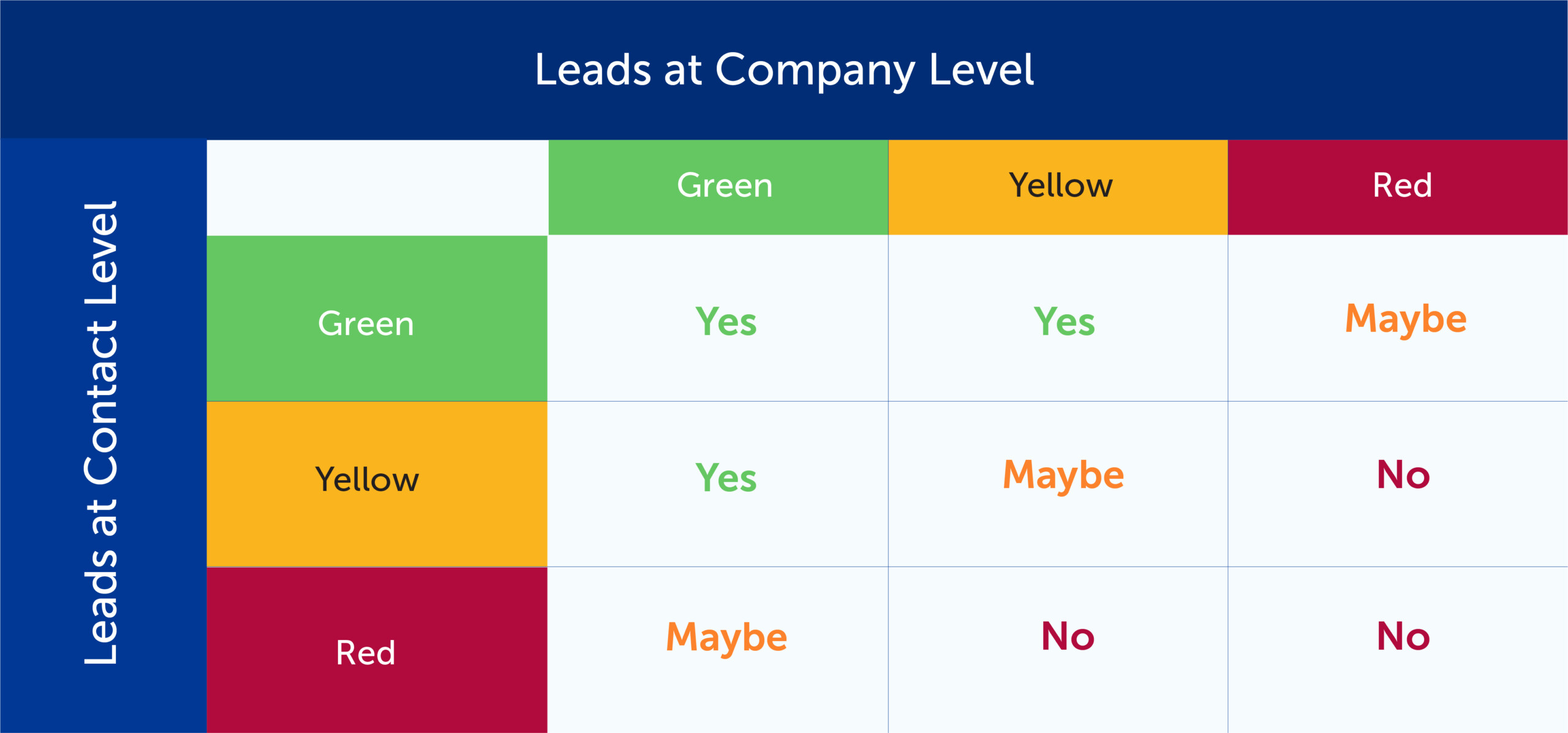Inbound lead conversion is always one of the biggest concerns for marketing and sales departments. We’re constantly looking for new ways to maximize lead conversion but typically struggle with poor lead quality, even as the conversion numbers increase.
Why is Lead Quality Important?
The answer comes down to this – time is money. Lead quality is one the biggest drivers of go-to-market efficiency in your business. It’s vital that you are able to quickly decipher the quality of a lead so that your team can spend their precious time in the most efficient way possible.
When you look at your contact’s job title, can you predict accurately if they are a user, influencer, or buyer of your product or service? If the answer is no to all of these questions, that lead is definitely not worth your time and will be a waste of resources. For example, if I sell software to the financial community in North America, getting leads from engineering teams in Europe won’t help me. Those leads will never convert.
Persona and job titles are only one part of the equation, however. You will also want to know if the lead is with a company that has the budget, a need for your solution, or if they’re currently using a competitor. Getting a lead from a stand-alone financial advisor when your software costs $50,000 annually doesn’t do much good. You’d need that financial advisor to be a part of a 100+ employee enterprise to have any chance of making that sale.
Foundational to lead quality is the accuracy and details of the B2B lead data itself. An “all leads are created equal” mentality is a guaranteed way to drive down your go-to-market efficiency. When there is a lack of adequate information, or the contact details are wrong or missing, that mentality prevails and problems arise. It creates a situation where the organization wastes money maintaining lead databases that will not convert effectively, will continue to bloat, and cost a lot of money.
According to reports, inaccurate contact data wastes 27% of your sales reps’ time yearly! So, a data-driven lead quality definition and commitment to gathering and maintaining quality data eliminates a huge amount of wasted time and effort – making you a marketing hero.
It Sounds Easy, But Where Do I Begin?
Improving lead quality is a challenging and continuous process. In my experience, these are the primary steps to ensure an improvement in your lead quality, or more importantly, your go-to-market efficiency.
If you build up a disciplined approach to defining lead quality and operating with that definition in mind, existing money and time produce more closed-won revenue with the same number and types of leads you have today. Add more leads to that mix and your team will enjoy the rarified air of strong growth.
1. Start By Defining Lead Quality at the Company or Account Level
First and foremost, if you haven’t read my previous blog, The 5x Pipeline Efficiency Play In a Difficult Economy– stop reading this and go read that first! You absolutely must define your target market before thinking about lead quality. By building your ICP accurately, you’ll be able to see up to a 5x improvement in your marketing and sales efforts simply by focusing on a part of the market where you win more often, close bigger deals, and have more expansion and net revenue retention (NRR). We have a great resource on defining your ICP to drive revenue that is worth reading, too.
Moving on, your lead quality definition should start at the account level. This is the first and most important signal. Ask yourself, is that lead within your ICP? You always want to maximize efficiency, so there’s no need to target leads that aren’t well-suited for your business. Even the best titles will struggle to convert if the product fit is off, or at best you are signing yourself up for churn.
Think of your leads as green, yellow and red.
Green: These are the best possible leads. In your ICP with a need for your solution, you’re confident that these leads will go somewhere.
Yellow: These are leads that are good, but not great. They may be a bit outside your ICP, but you can still see their potential to close.
Red: The leads are pretty far out of your wheelhouse and simply aren’t worth the time and effort required. You don’t want to waste anyone’s time, so these leads you may have to politely decline.
Before you dive into specific titles and contact information, ensure that you’re feeling confident, investing in your greens (and even yellows).
2. Define Lead Quality at the Contact Level
As you did at the account level, take the time to map out the job titles that define the personas of these leads. Be sure to keep this contact-level definition independent of your account definition.
As a company grows its lead database or invests in B2B intelligence to jumpstart the process, it gains access to hundreds of contact details for potential decision-makers, buyers, influencers, and users. It’s time to do the green, yellow, red process all over again.
Green: Your decision-makers. These are who you certainly want to talk to.
Yellow: These are your influencers and buyers. They’re the ones to help you seal the deal!
Red: Anyone else, really. If they don’t have a hand in the sale, they probably aren’t going to be much help.
Then you can see where these contacts fit in with your account definition. What color combo are they? Yellow-green? Green-green? Decide if their cumulative rating makes this lead worth pursuing.
While some teams like to get more complex in mapping out the various personas, in my experience these 3 levels are enough to set a super strong foundation. You can always add complexity later!
3. Build Out a Lead Quality Scoring System
Your lead quality scoring system simply combines these two data sets into a quantifiable data-driven definition of lead quality. You may be asking “What about intent data?” or “What about my marketing-qualified leads?” We will cover those questions in a moment, but be patient. Those are different questions and different data for different purposes. Lead quality is meant to help your team to determine if the leads you’re creating have potential now or in the future.
This simple approach gives you a clear and quantifiable measurement of lead quality and a map of how to deal with these leads in partnership with sales.
Buyers: A buyer in an ICP account should go to your best and most experienced AEs. A buyer outside the ICP may go to a less-experienced AE learning how to examine, score, and qualify. Some of these leads will close, but the risk is lower.
Users: If you get a lot of users that come in as leads, often an automated experience or a product-led growth (PLG) motion is best suited for this persona.
Influencers: Finally, there are influencers who might benefit from some marketing love via automation before being handed off to an AE for follow-up.
No two companies are the same, and how you decide to segment and route leads based on their quality score is a great place to be at! It means you have a clear definition, data quantified, and you’re working with sales to decide together how to best handle them. You’re aligned and working together to get better which is a huge benefit of a data-driven and quantified lead quality definition.
4. Lead Quality Should Live Independently From Readiness to Buy
Much has been written about the lead scoring process including the marketing-qualified lead (MQL) and sales-qualified lead (SQL) debate, including our article on how to maximize your SQL generation efforts. Now understand, lead scoring is independent of lead quality, but they go hand-in-hand.
Lead scoring is absolutely vital because it helps prioritize leads further down the sales funnel, resulting in better conversion rates. (NOTE: Intent, along with a marketing activity score, is a more modern approach to lead scoring that we covered in depth in this webinar for those interested in learning more.)
Higher-scoring leads, however you score them, are likely already on their buying journey and will be converted easier and faster with dedicated sales efforts than those who are not. But this is where I often see teams make two mistakes. First and foremost, don’t define your lead quality based on where they are in the buying cycle. For example, if a VP in one of your ICP companies attends a webinar or downloads a whitepaper, that doesn’t instantly mean they’re ready to buy. Certainly, the lead quality is outstanding, but having sales tell you, “You handed me a lead not yet in market!” is a lead hand-off timing issue, not a lead quality issue.
Marketing’s job is to both build brand and harvest demand. When that buyer enters the sales cycle, if they have seen good content and have been treated well, you can rest assured your team will get their shot at their business.
It’s a simple fact that not all leads are in the same place in their buying journey as they walk through the front door. Some of them may not even be on the journey at all! Lead scoring helps you know when to route for sales follow-up, but treat it as a prioritization lever and not a lead quality lever.
5. Only Count Your Quality Leads
A surefire way to get yourself into trouble as a marketing team is to count and report leads that are of poor quality. Many marketing teams do this as a “vanity” metric (e.g., I drove 500 leads this week!).
If 80% of those leads are personal emails, students, or other low-quality leads, only report on 100 and not all 500, and report your cost per lead accordingly. Any other approach will create major issues. At a minimum, a credibility problem for the marketing team, or at maximum, bad financial decisions that waste a ton of valuable resources.
Remember That Pipeline Generation Is a Team Sport
Hopefully, in reading this blog, you now have a clear idea of how to define and quantify lead quality. While you may be tempted to get this done in a week, you should get buy-in from sales and your executive leadership on every step in the process. Ensure that your quality definition is clear, quantifiable, and agreed upon by everyone.
We all need to be on the same page to operationalize lead quality, but once you do, the team is winning or getting better every day! That’s what alignment does for best-of-breed go-to-market teams and it all starts with your lead quality definition.
Related Blog – The Ultimate Guidebook To Building a Strong Sales Pipeline





